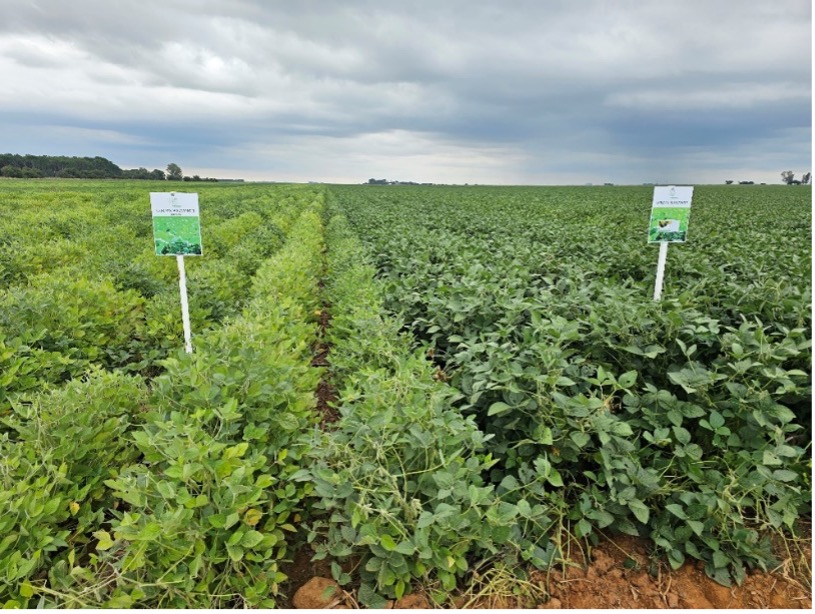Effective inoculation of soybean
by Dr. Stefan van Wyk, Victus Bio

Left sides: Plants inoculated using producer’s standard practices. Right sides: Plants inoculated with RX-N Soybean™: Ultra.
The need for nitrogen
Nitrogen is an essential macronutrient required for the growth and development of plants. All vital processes in plants need nitrogen as a main building block in proteins and enzymes. It can therefore be said that the availability of nitrogen ultimately also impacts crop productivity. Therefore, by reducing the dependence on nitrogen fertilisation in agriculture, several economic and environmental benefits can be achieved.
Legumes getting their nitrogen fix
Legumes have evolved the ability to fix atmospheric nitrogen through the symbiotic relationship they form with (nitrogen-fixing) specialised soil bacteria called rhizobia. During the symbiotic interaction, specific communication- signalling molecules are produced by both the bacteria and the plant, which leads to the formation of a highly specialised plant root structure, namely nodules. This process of biological nitrogen fixation is carried out by a specialised group of prokaryotes.
These organisms utilise the enzyme nitrogenase to catalyse the conversion of atmospheric nitrogen (N2) to ammonia (NH3) and is an environmentally friendly solution to address nitrogen deficiency and increase crop productivity.
Under favourable conditions and limited soil nitrogen, hundreds of nodules can be formed on the root system to supply the host legume plant with sufficient nitrogen.
This symbiotic interaction, however, is very host-specific, as there are only a limited number of host plant species with which each rhizobium strain can engage in symbiotic interaction. To ensure good biological nitrogen, it is imperative to use the correct rhizobium bacteria strain (the one which is specific to the legume crop it is intended for), before the seed is planted.
To enable the full potential of bacterial inoculants, an inoculant must:
- Be the correct strain of rhizobium for the specific legume crop;
- Contain a high concentration of rhizobium bacteria;
- Have a long shelf-life;
- Be free from undesired contamination;
- Be appropriately packaged and stored until use; and
- Be able to survive adverse conditions (Table 1).
Table 1: Harsh environmental conditions kill rhizobia.

Several factors can affect the survival and therefore the effectiveness of rhizobium inoculants, depending on the application method (Table 2).
Table 2: Factors impacting survival of rhizobium inoculants for seed- and in-furrow applications.

Rhizobia are living organisms with simple needs to grow and survive. Once incorporated into the soil, conditions such as soil pH, temperature and salinity have a great influence on the survival of rhizobium (Table 3).
Table 3: Requirements for rhizobia to grow and survive.

RX-N: a bacterial legume inoculant for effective nitrogen fixation.
Victus Bio offers a range of biotechnologically advanced inoculants for legumes, which are distributed by Laeveld Agrochem, namely: RX-N Drybean™, RX-N Groundnut™, RX-N Lucerne™, RX-N Pea™, and RX-N Soybean™, amongst others. To illustrate the benefit of these products, one product range, RX-N Soybean™, is highlighted further as an example. RX-N Soybean™ contains Bradyrhizobium japonicum strain WB74, which is specific for soybean crops.
This formulation presents various benefits and advantages to the producer, including:
- High concentration of viable rhizobium bacteria, the minimum legal requirement is > 2,0 x 109 cfu/ml which is the legal minimum for liquid inoculants. Independent tests done of RX-N proved a high concentration of viable rhizobium bacteria consistently above 6,5 x 109 cfu/ml.
- Osmotic protectants that help the bacteria to survive for longer on the seed surface and protect bacterial cells against adverse conditions such as water and chemical stresses in different agricultural environments.
- Permeable packaging enables bacteria to breathe during storage, allowing bacteria to remain metabolically active for extended periods of time (6 months – which is the legal minimum for inoculants).
- Signalling compounds which facilitate communication between the plant and bacteria, enabling quicker establishment of symbiotic interactions, causing the biological nitrogen fixation to start sooner.
- Thermal insulating packaging prevents temperature spikes during storage and transport, protecting the bacteria until used.

Figure 2: Differences observed in the field of the same trial location. Plants inoculated using producer’s standard practices on the left (leaves, roots, appearance) and plants inoculated with RX-N Soybean™: Ultra on the right (leaves, roots, appearance).






